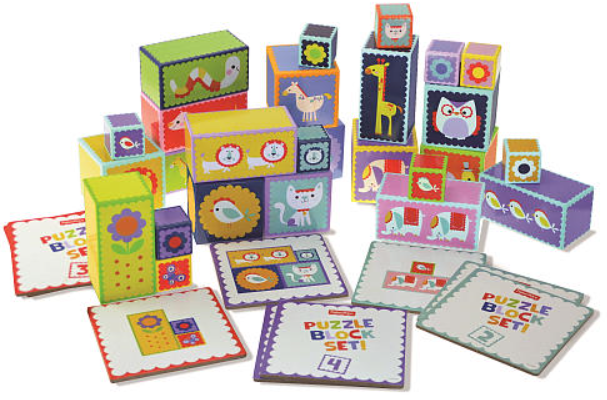 |
My First Activity Wood Block Set |
My First Activity Wood Block Set is a quality wooden block set from Fisher Price. There are 27 blocks total: eight large squares, eight large rectangles, and 11 small squares. Each block has a nature picture (animal(s) or flower(s)) on one side, and the same picture on the opposite side. A block might show one, two, or three of the same objects. The other four sides are colored but have no pictures.
Since I am all about the pattern cards, my first thought is that it is a shame that there are so many blocks and only nine cards. The
nine pattern cards are thick cardboard and have one pattern each. There
are three 2-block patterns, three 3-block patterns, and three 4-bock
patterns.You can always stack the blocks yourself, take pictures, and print them out to make your own cards. They look durable and should last a good long time.
For more of this type of activity, see my post on What's in Your Therapy Box: Pattern Block Edition.
Try this:
- Start slow by giving the child each piece in order and letting him arrange/stack it to build per a puzzle card.
- Place only the pieces needed for a puzzle and the puzzle card in front of the child to avoid confusion from too many pieces.
- Put all the pieces on the table and ask the child to find each piece in the group as he needs it.
- Use positional language consistently, such as on top of, next to, under.
- Find all the pieces for the card ahead of time. Place only those pieces and the card in front of the child if you want to focus on a single goal, such as spatial orientation. This may decrease frustration that might be added by working on too many things at once.
- Stand the card upright so that the child understands that the model will be built up.
- Cover all pieces on the card except for the row or column you are working on if the child does not know where to start, how to proceed, or the need to start from the bottom.
- Place the blocks in different orientations, such as upside down and on their sides. Ask the individual to find them and orient them correctly before stacking.
- Build a tower. How many of the blocks can you use? Build again and try to add one more.
- Stack a tower with only animals. Stack a tower with only flowers. Stack a tower with only solid colors showing forward.
- Stack only blocks with two items and count as you go. Stack a tower with only blocks with three items and count as you go.
- Work on visual discrimination, figure ground, spatial relations, visual closure, visual form constancy, creating a 3D model from a 2D model, in-hand manipulation, manual dexterity, executive functioning skills, process skills, play and leisure exploration and participation
-
In the box: 27 solid wooden blocks, 9 pattern cards.Ages 2+
If you are interested in purchasing this item or just want more information, click on the image below.



No comments:
Post a Comment
Thank you for taking the time to comment.